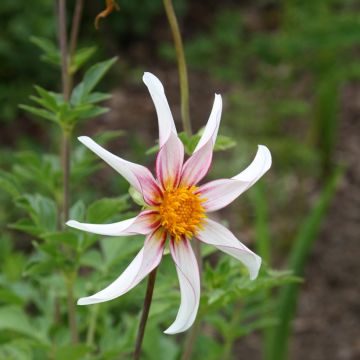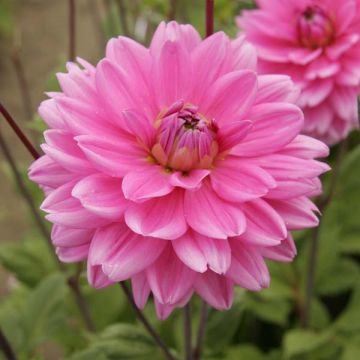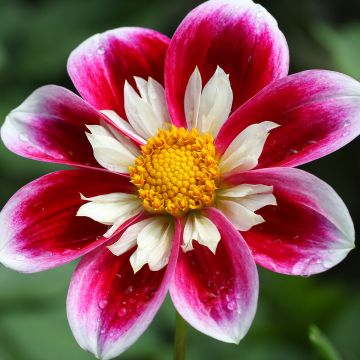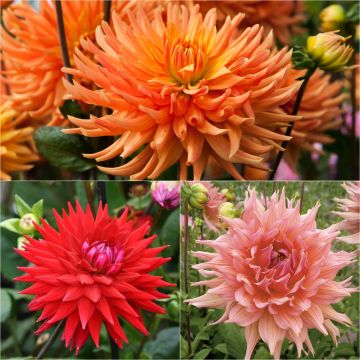

Dahlia Honka Pink


Dahlia Honka Pink


Dahlia Honka Pink


Dahlia Honka Pink
Dahlia Honka Pink
Dahlia Pink
Dahlia
Very aesthetically pleasing slender petals that provide a nice contrast compared to round varieties, for example. Highly floriferous. Height exceeds the stated 90 cm (35in).
Marie-Laure, 15/09/2021
This item cannot be shipped to the selected country
Delivery charge from €5.90
More information
Schedule delivery date,
and select date in basket
This plant carries a 6 months recovery warranty
More information
We guarantee the quality of our plants for a full growing cycle, and will replace at our expense any plant that fails to recover under normal climatic and planting conditions.
From €5.90 for pickup delivery and €6.90 for home delivery
Express home delivery from €8.90.

Does this plant fit my garden?
Set up your Plantfit profile →
Description
Dahlia 'Honka Pink' is a variety from the Honka series, which is distinguished by its slender and incurved petals (with rolled edges) along the entire length. 'Pink', as its name suggests, features a beautiful dark fuchsia-pink colour, which is lighter on the inside of the petals and bears white tones near the centre of the flower, which is occupied by a golden yellow heart. This tall dahlia produces thin and elegant stems that gracefully sway above the foliage. The light and vibrant star-shaped flowers bloom from July to October, and integrate well into perennial plant beds.
Dahlias belong to the Asteraceae family and are originally from the high plateaus of Mexico. There are currently thousands of horticultural varieties that have conquered gardens worldwide. They are tender perennials with fleshy tubers.
Dahlia 'Honka Pink' is a perennial plant that has swollen tuberous roots. Gathered in bundles, these tubers produce upright, hollow, and ramified stems, bearing compound, odd-pinnate leaves with rounded leaflets. The sturdy, fleshy stems, 90cm (35in) in height, are topped with inflorescences called heads, which are 10cm (4in) wide. The Honka series is part of the horticultural family of star-shaped dahlias, defined by the shape of the flower.
Remove faded flowers to encourage new blooms. You can use cut flowers to make colourful bouquets, combining them with other varieties.
'Honka Pink' pairs particularly well with blue flowers and silver foliage. This dahlia will create colourful spots in the front of beds alongside echinaceas that bloom at the same time. It will also work well with daylilies and asters.
Dahlias are stars of borders and ornamental gardens, confidently accompanying the most beautiful flowers. However, they are also appreciated alongside vegetable plants. In Mexico, this tuberous plant was first cultivated as a root vegetable for consumption. Its poor taste qualities quickly saw it categorised as an ornamental plant. Since then, the interest in their beautiful exuberance has never waned.
Tips: when planting, consider the ultimate dimensions of the dahlia.
Report an error about the product description
Dahlia Honka Pink in pictures
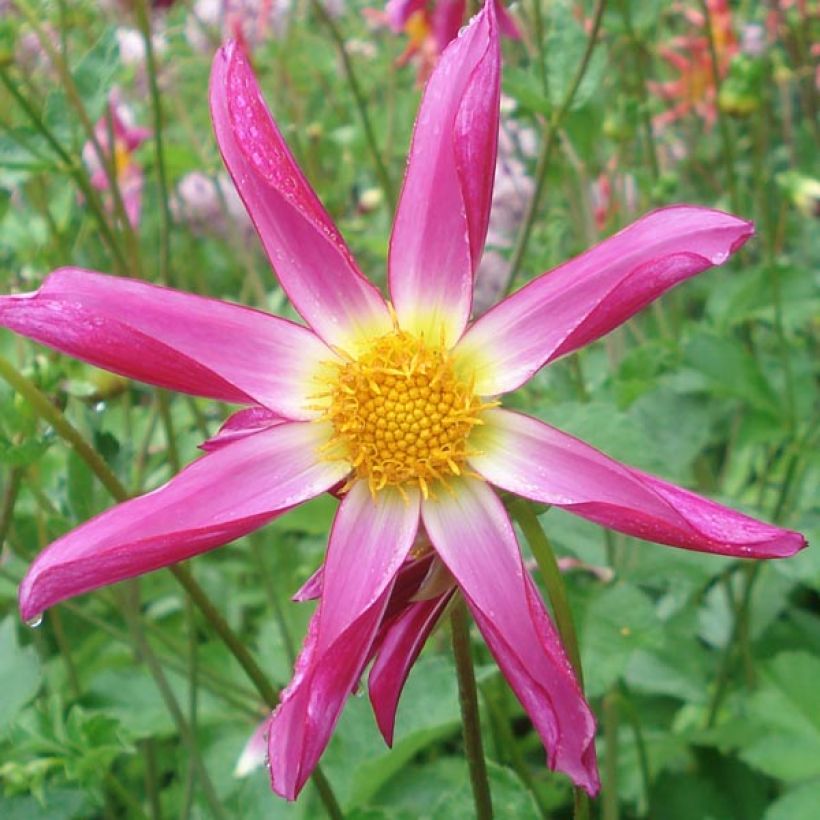





Plant habit
Flowering
Foliage
Botanical data
Dahlia
Pink
Asteraceae
Dahlia
Cultivar or hybrid
Other Honka Dahlia
Planting and care
It is easy to grow in all regions. Plant in spring as soon as the last frost has passed. For abundant flowering, plant the tubers in full sun in rich, moist but well-drained soil. Stagnant moisture causes tuber rot. Amend the soil with compost and sand, if necessary. Work the soil deeply and enrich it, for example, with crushed horn or dehydrated blood. Place your tuber and crumble the soil well to fill without air pockets. Cover with about 6cm (2in) of soil. At the end of planting, water once abundantly and then repeat this watering regularly during the first 6 weeks to help with rooting.
Dahlias are sensitive to cold, so they need to be overwintered. Dig the tubers up when the first frost has blackened the foliage. Carefully remove the tubers. Remove as much soil as possible. Let the foliage dry so that the tubers can replenish their reserves. Then cut the stems to 10cm (4in). Spread your bulbs in a box lined with newspaper. Store them in a frost-free, dry, cool, and dark place, such as a garage or attic. In mild regions without frost, or those close to the coast, it is possible to leave them in place. In this case, simply cover the ground with a carpet of leaves or straw for protection.
Planting period
Intended location
Care
-
, onOrder confirmed
Reply from on Promesse de fleurs
Dahlias
Haven't found what you were looking for?
Hardiness is the lowest winter temperature a plant can endure without suffering serious damage or even dying. However, hardiness is affected by location (a sheltered area, such as a patio), protection (winter cover) and soil type (hardiness is improved by well-drained soil).

Photo Sharing Terms & Conditions
In order to encourage gardeners to interact and share their experiences, Promesse de fleurs offers various media enabling content to be uploaded onto its Site - in particular via the ‘Photo sharing’ module.
The User agrees to refrain from:
- Posting any content that is illegal, prejudicial, insulting, racist, inciteful to hatred, revisionist, contrary to public decency, that infringes on privacy or on the privacy rights of third parties, in particular the publicity rights of persons and goods, intellectual property rights, or the right to privacy.
- Submitting content on behalf of a third party;
- Impersonate the identity of a third party and/or publish any personal information about a third party;
In general, the User undertakes to refrain from any unethical behaviour.
All Content (in particular text, comments, files, images, photos, videos, creative works, etc.), which may be subject to property or intellectual property rights, image or other private rights, shall remain the property of the User, subject to the limited rights granted by the terms of the licence granted by Promesse de fleurs as stated below. Users are at liberty to publish or not to publish such Content on the Site, notably via the ‘Photo Sharing’ facility, and accept that this Content shall be made public and freely accessible, notably on the Internet.
Users further acknowledge, undertake to have ,and guarantee that they hold all necessary rights and permissions to publish such material on the Site, in particular with regard to the legislation in force pertaining to any privacy, property, intellectual property, image, or contractual rights, or rights of any other nature. By publishing such Content on the Site, Users acknowledge accepting full liability as publishers of the Content within the meaning of the law, and grant Promesse de fleurs, free of charge, an inclusive, worldwide licence for the said Content for the entire duration of its publication, including all reproduction, representation, up/downloading, displaying, performing, transmission, and storage rights.
Users also grant permission for their name to be linked to the Content and accept that this link may not always be made available.
By engaging in posting material, Users consent to their Content becoming automatically accessible on the Internet, in particular on other sites and/or blogs and/or web pages of the Promesse de fleurs site, including in particular social pages and the Promesse de fleurs catalogue.
Users may secure the removal of entrusted content free of charge by issuing a simple request via our contact form.
The flowering period indicated on our website applies to countries and regions located in USDA zone 8 (France, the United Kingdom, Ireland, the Netherlands, etc.)
It will vary according to where you live:
- In zones 9 to 10 (Italy, Spain, Greece, etc.), flowering will occur about 2 to 4 weeks earlier.
- In zones 6 to 7 (Germany, Poland, Slovenia, and lower mountainous regions), flowering will be delayed by 2 to 3 weeks.
- In zone 5 (Central Europe, Scandinavia), blooming will be delayed by 3 to 5 weeks.
In temperate climates, pruning of spring-flowering shrubs (forsythia, spireas, etc.) should be done just after flowering.
Pruning of summer-flowering shrubs (Indian Lilac, Perovskia, etc.) can be done in winter or spring.
In cold regions as well as with frost-sensitive plants, avoid pruning too early when severe frosts may still occur.
The planting period indicated on our website applies to countries and regions located in USDA zone 8 (France, United Kingdom, Ireland, Netherlands).
It will vary according to where you live:
- In Mediterranean zones (Marseille, Madrid, Milan, etc.), autumn and winter are the best planting periods.
- In continental zones (Strasbourg, Munich, Vienna, etc.), delay planting by 2 to 3 weeks in spring and bring it forward by 2 to 4 weeks in autumn.
- In mountainous regions (the Alps, Pyrenees, Carpathians, etc.), it is best to plant in late spring (May-June) or late summer (August-September).
The harvesting period indicated on our website applies to countries and regions in USDA zone 8 (France, England, Ireland, the Netherlands).
In colder areas (Scandinavia, Poland, Austria...) fruit and vegetable harvests are likely to be delayed by 3-4 weeks.
In warmer areas (Italy, Spain, Greece, etc.), harvesting will probably take place earlier, depending on weather conditions.
The sowing periods indicated on our website apply to countries and regions within USDA Zone 8 (France, UK, Ireland, Netherlands).
In colder areas (Scandinavia, Poland, Austria...), delay any outdoor sowing by 3-4 weeks, or sow under glass.
In warmer climes (Italy, Spain, Greece, etc.), bring outdoor sowing forward by a few weeks.




































